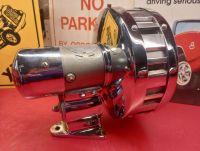Class C
| Federal Signal Class C | |

| |
| Company | Federal Electric
Federal Enterprises Federal Sign & Signal
|
|---|---|
| Produced | 1930s-1970s |
| Type | Electromechanical Omnidirectional |
| Voltage | 6/12 V DC |
| Succeeded by | Federal Signal Q-Siren |
The Class C (sometimes called the Coaster Siren) is a line of vehicular sirens that was produced by Federal Electric and later Federal Sign & Signal, and during the time of its production was one of the most numerous and famous electric vehicular sirens on the market. It was Federal's main vehicular siren until the introduction of the Q-Siren and Class V, where it would be the midrange option instead.
History
WIP
The Class C was originally released sometime in the 1930s, with advertisements dating back to at least 1935. With other manufacturers such as B&M and Sterling seeing much success in the vehicular siren market, Federal Electric introduced the Class C to compete. The Model C-3 was discontinued by the 1950s. The Class C would be sold until the 1970s, when it and the rest of Federal's mechanical vehicular sirens were phased out in favor of the Q2B and its electronic sirens. Most Class C sirens have been retired, now often ending up in the hands of collectors and enthusiasts; it is not uncommon to find used Class C sirens for sale.
Design
The Class C is a very basic siren, featuring a bare rotor/stator and motor placed atop a small stand, furnished with a protective grille or light and a chrome finish. On C-5 and C-6 models, the motor is protected by a rounded motor cover, while the motor is bare on the C-4 and C-3. The Class C has no intake horn or tube unlike other vehicular sirens of its day, relying purely on a basic grille intake. The Class C is equipped with finger guards on the stator ports to prevent user injury due to its small size, and the siren sits on a small stand for mounting. On brake-equipped models, the brake mechanism is integrated into the stand. The Class C was available with a 6 or 12 V DC electric motor, designed primarily to reduce the amp draw and drain on the batteries of the fire engine it is mounted on. The Class C is an 8 or 12-port siren, driven at a high speed with a long coasting time of roughly three minutes. The Class C was available with a brake to bring the siren quickly to a halt if needed or could be free rolling instead.
Models
- C-6B - Chrome finish, equipped with a brake and Federal Propello-Ray beacon light in place of the grille. 8-port.
- C-6A - Same as above but is free-rolling without a brake.
- C-5LB - Same as the C-6B, but with a standard flashing red light instead of the Propello-Ray. Equipped with a brake.
- C-5LA - Same as the C-5LB, but without a brake.
- C-5GB - Equipped with a grille intake instead of a light and equipped with a brake.
- C-5GA - Same as the C-5GB, but without a brake.
- C-4 - Chrome finish, grille only. Designed primarily as a concealed siren. Equipped with a brake as standard and lacks a protective motor cover. 12-port.
- C-3 - Equipped with an intake horn, free-rolling only. Advertised as the "C3 Long Roll Siren". Lacks a protective motor cover. 8-port.
Gallery
-
A Class C6B (brake, Propello-Ray equipped) Coaster Siren.
-
A Class C5GA (Grille, no brake) Coaster Siren.
-
A Class C-3 Long Roll Siren.


